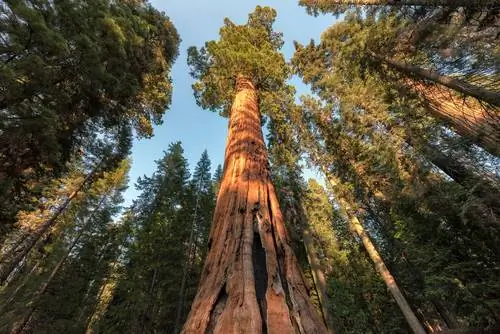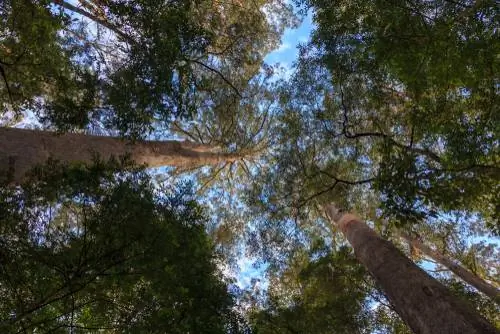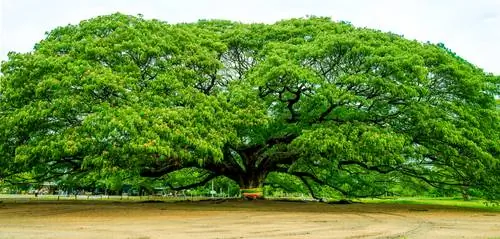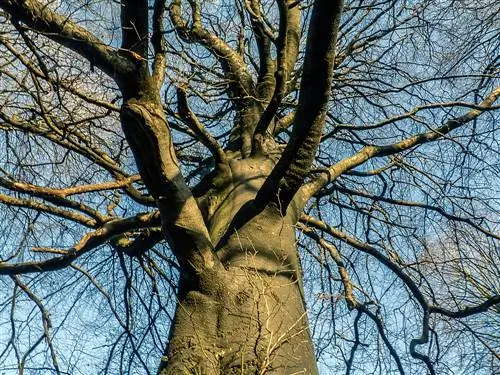- Author admin [email protected].
- Public 2023-12-16 16:46.
- Last modified 2025-01-23 11:22.
Trees are extremely fascinating: not only can representatives of their group live for several thousand years, some of them are also among the largest living creatures on earth. The giant trees, which can be found primarily in the national parks of the USA and Australia, reach well over 100 meters in height.

Which is the largest tree in the world?
The tallest tree in the world is the coast redwood “Hyperion” with a height of 115.72 meters in Redwood National Park, California. The largest tree is the giant sequoia “General Sherman Tree” in Sequoia National Park. The thickest tree is in Oaxaca, Mexico - a Mexican bald cypress with a trunk circumference of 46 meters.
How big is the largest tree in the world?
“Trees are more sensible than people, they always strive for the light.”
The term “big” can be interpreted in different ways. “Tall” in relation to trees can mean their height, but also their sheer mass or width. Therefore, various specimens are shortlisted for the title of “largest tree in the world”.
Tallest tree
The tallest living tree in the world is currently considered to be a coast redwood (bot. Sequoia sempervirens) called “Hyperion”, whose current height was measured at 115.72 meters. As incredible as it sounds, this impressive giant was only discovered in 2006 as it is located in a fairly remote part of Redwood National Park on California's Pacific coast. By the way, there are other record-breaking trees of the same species in its immediate vicinity:
- “Helios” with a height of 114.09 meters
- “Icarus” with a height of 113.14 meters
- and “Daedalus” with a height of 110.76 meters
An Australian giant eucalyptus (Eucalyptus regnans) discovered in the 19th century is said to have been even higher, measuring an incredible 132.58 meters in height. Unfortunately, this record was only discovered after the tree had already been felled.
Repost @mr_globetrotter87<•••• just stop by!!! largesttreeintheworld outdoor bushcraft nature natur wonderful_places naturelovers adventures germanblogger explore exploring hiking outside ourplanet plant weekend dailyplanet highesttree hiking berlin globetrotter foggy picoftheday
A post shared by Ina (@freshfoodandoutdoor) on Nov 4, 2017 at 1:04am PDT
The most powerful tree in the world
The mightiest tree in the world is also a sequoia, but one of the mountain sequoia or giant sequoia (Sequoiadendron giganteum). Known as the “General Sherman Tree,” this tree is probably the most voluminous tree in the world at around 1,490 cubic meters. It can be viewed in the Giant Forest of Sequoia National Park in California. By the way, the “General Sherman Tree” is not only particularly large, but also very old: Its age is estimated to be around 1,900 to 2,500 years. However, that doesn't make it one of the oldest trees in the world.
Thickest tree in the world
This honorary title is currently held by a Mexican bald cypress (Taxodium mucronatum) called “Árbol del Tule”, which impresses with a trunk circumference of an impressive 46 meters. Although this specimen, located in Santa María del Tule, Mexico (state of Oaxaca), is not unusually high at around 42 meters high, it is exceptionally heavy with an estimated weight of 636 tons.
This video also provides an entertaining overview of the five most incredible trees in the world:

How big is the largest tree in Germany?
But there are also interesting record holders to admire under the trees in Germany. Germany's currently tallest tree is a Douglas fir (Pseudotsuga menziesii), known as the "Waldtraut vom Mühlenwald", which, according to measurements in 2017, is exactly 66.58 meters high. In the meantime, however, the very fast-growing tree may have gained a few more centimeters, as the tree was only planted in 1913 and is still growing. On average, Douglas firs grow around 30 centimeters per year if the growing conditions are right. So you can continue to be excited. By the way, “W altraud” can be visited near Freiburg, in the so-called Mühlenwald.
The thickest tree in Germany, however, is in the north, in the small Emsland community of Heede. The “thousand-year-old linden tree” is a summer linden tree with a trunk circumference of 18 meters - there is no larger linden tree in all of Europe. A full 12 adults are needed to hug this tree. The crown of this tree is very impressive with a diameter of about 30 meters. It is supported by several branches that branch off from the main trunk at a height of about three meters. Many old and large trees have divided trunks that are hollow inside, but not this lime tree: Untypically, its thick trunk is still comparatively solid and has only a few hollows.
What is the maximum height that trees can grow?
As impressive as the giant trees presented here are: no growth lasts forever. Tree scientists - so-called dendrologists - have calculated the maximum growth height of a tree before its supply system collapses and the tree dies because it can no longer support itself: The scientists' estimates in this regard range from a maximum height of between 130 and 150 meters. Of course, this information does not apply to every tree species or to every location, because only certain trees can reach such gigantic dimensions - and only if they find sufficient water and nutrients, are in a quiet location with sufficient light and, last but not least, not to be cut down prematurely by humans.
These tree species grow particularly tall
These tree species are considered to be particularly tall:

Giant eucalyptus trees are, as the name suggests, huge
- Giant eucalyptus (Eucalyptus regnans): evergreen tree native to Australia that can grow to around 65 meters high in just 50 years. The current tallest example of this species is in Tasmania and is 99.6 meters high.
- Coast redwood (Sequoia sempervirens): evergreen conifer from the cypress family, particularly common in California and a so-called “living fossil”, because sequoia trees were already around at the time of the Dinosaur
- Giant sequoia (Sequoiadendron giganteum): evergreen conifer native to the Californian Sierra Nevada and related to the coast redwood
In addition to these species, which all represent the largest tree specimens, there are several other tall trees that also reach impressive dimensions in individual cases. These include, for example:
- Yellow meranti tree (Shorea faguetiana): a specimen of this species in Borneo is currently the tallest living deciduous tree with a height of 100.8 meters
- Common Douglas fir (Pseudotsuga menziesii): very fast-growing, but does not live particularly long, on average around 400 years, can reach heights of over 100 meters
Average height of different tree species
The following table shows which growth heights the tree species commonly found in our mixed forests reach - provided they are allowed to grow and are not cut down by forestry workers beforehand. It turns out that Central European trees can grow to an average height of around 30 meters. What catches the eye, however, are the different types of fir, which can reach 50 meters or, as in the case of the Nordmann fir, even up to 70 meters in good growing conditions.
| Type of tree | Latin name | Possible growth height |
|---|---|---|
| European larch | Larix decidua | up to 35 meters |
| Scotch spruce/ Norway spruce | Picea abies | up to 40 meters |
| Common Black Locust / Mock Acacia | Robinia pseudoacacia | up to 22 meters |
| Field maple | Acer campestre | up to 25 meters |
| Sycamore maple | Acer pseudoplatanoides | up to 30 meters |
| White Willow | Salix alba | 6 to 30 meters |
| Broken willow | Salix fragilis | 3 to 15 meters |
| Nordmann fir | Abies nordmanniana | up to 70 meters |
| White Fir | Abies alba | up to 50 meters |
| Pedunculate oak | Quercus robur | up to 45 meters |
| hornbeam | Carpinus betulus | up to 28 meters |
| Common beech | Fagus sylvatica | up to 40 meters |
| Winterlinde | Tilia cordata | up to 30 meters |
| Common Horse Chestnut | Aesculus hippocastanum | up to 35 meters |
| Field elm | Ulmus minor | up to 30 meters |
Excursus
This is how high our fruit trees grow
In comparison, fruit trees neither reach a particularly old age nor grow particularly large. The outliers here are sweet cherry and walnut trees, which, with growth heights of well over 20 meters, require a lot of space in the garden and, at around 60 to 80 years, are also older than most apple trees.
| Fruit tree | Latin name | Average height |
|---|---|---|
| Cultivated Apple | Malus domestica | up to 10 meters |
| Culture pear | Pyrus communis | up to 20 meters |
| Sweet cherry | Prunus avium | up to 28 meters |
| Sour cherry | Prunus cerasus | up to 8 meters |
| Cultivated Plum | Prunus domestica | 6 to 10 meters |
| Quince | Cydonia oblonga | 4 to 8 meters |
| Walnut | Juglans regia | 15 to 25 meters |
Why do some trees grow so extremely tall?

This rain tree is the largest of its kind in Thailand
Of course, in order for these giant trees to reach their impressive height, a number of factors have to come together. In addition to genetics - the maximum height of growth is genetically determined for many species - environmental factors play a major role. The trees only grow so large where optimal growth conditions prevail. Without the appropriate resources, however, they remain significantly smaller - after all, sequoia trees planted here don't grow anywhere near as tall. For this reason, there are often several tall specimens next to each other, because the site conditions enabled different trees to grow extremely.
In addition to these factors, other causes also play a major role: resistance is one of them. The largest living creatures on earth, the sequoia trees, for example, have a bark that is up to 70 centimeters thick - which is also fireproof because it secretes a protective liquid over the outer skin when it is hot and is extremely capable of regeneration. The high tannic acid content also keeps insects and fungal pathogens away, so that Sequoia is practically immune to all kinds of pests and diseases.
Frequently asked questions
Can you visit the tallest tree in the world?
The location of the tallest tree in the world - “Hyperion” is kept secret to protect it from overly intrusive tourists. As unbelievable as it sounds, this tree has shallow roots, which is why trampling feet could cause significant damage to its roots. In addition, the specimen is in a remote location that is neither paved nor signposted.
Are the tallest trees also the oldest?
No, because height has nothing to do with age, but rather with the speed of growth. However, sequoia trees can also reach an extremely long age of several thousand years.
And which is the smallest tree in the world?
The so-called herb willow (Salix herbacea) is considered the smallest tree in the world. Although it only grows around ten centimeters high, it has everything that makes a tree: a trunk, a crown, green foliage as well as flowers and fruits.
Tip
The primeval sequoia tree (Metasequoia glyptostroboides), which comes from China, is related to the two American species, but only reaches heights of between 30 and 35 meters.






